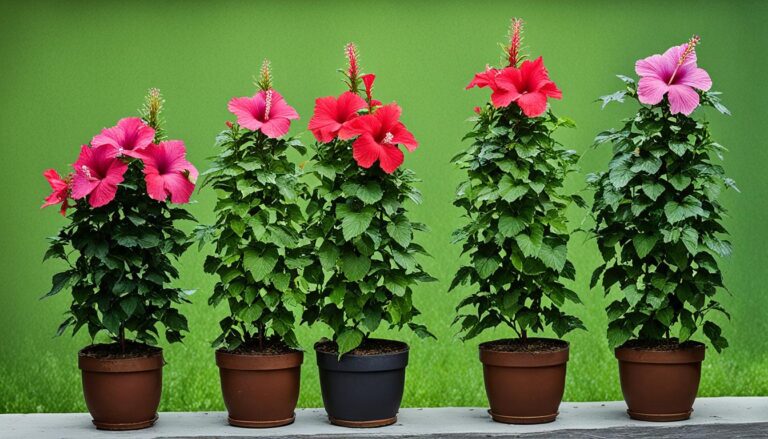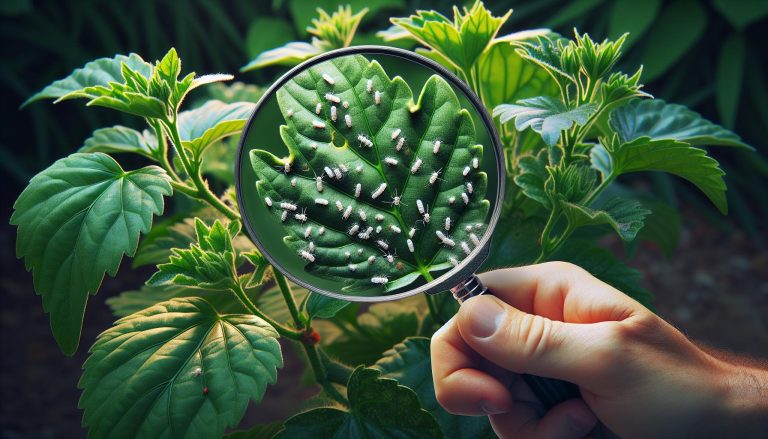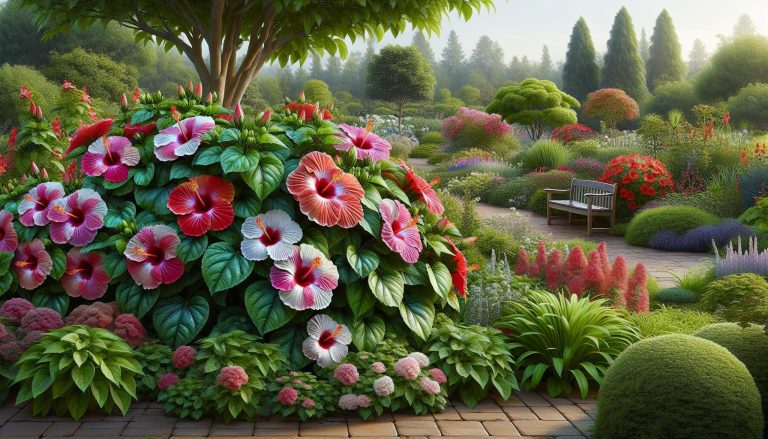Chinese Hibiscus Care: Tips for Vibrant Blooms and Winter Protection
As a gardening enthusiast, I’ve always been captivated by the vibrant beauty of Chinese hibiscus. These tropical stunners can transform any space into a colorful oasis, but they require specific care to thrive. Have you ever wondered how to keep your Chinese hibiscus blooming year-round?
I’ll share my tried-and-true tips for nurturing these exotic plants, whether you’re growing them indoors or out. From ideal light conditions to watering schedules, we’ll cover everything you need to know. Did you know that Chinese hibiscus can produce flowers up to 8 inches in diameter? With the right care, you’ll be rewarded with these spectacular blooms in no time.
What Is Chinese Hibiscus?
Chinese hibiscus (Hibiscus rosa-sinensis) is a stunning tropical flowering shrub native to East Asia. It’s prized for its large, showy blooms that can reach up to 8 inches in diameter. These eye-catching flowers come in a variety of colors, including red, pink, orange, yellow, and white.
Key features of Chinese hibiscus:
- Evergreen shrub or small tree
- Glossy, dark green leaves
- Trumpet-shaped flowers with prominent stamens
- Blooms throughout the year in tropical climates
- Can grow up to 15 feet tall in ideal conditions
Chinese hibiscus is versatile and adaptable. I’ve grown it both as a potted plant indoors and as a landscape shrub in warmer regions. It’s a popular choice for hedges, screens, and container gardens.
This hibiscus species thrives in:
| Condition | Ideal Range |
|---|---|
| USDA Hardiness Zones | 9-11 |
| Temperature | 60-90°F (15-32°C) |
| Soil pH | 6.0-6.5 |
Chinese hibiscus isn’t just ornamental; it’s also used in traditional medicine and as a natural hair conditioner in some cultures. The flowers are edible and often used to make teas or garnish dishes.
While it’s called “Chinese” hibiscus, this plant has become naturalized in many tropical and subtropical regions worldwide. It’s a beloved garden staple in places like Hawaii, Florida, and the Caribbean.
Ideal Growing Conditions for Chinese Hibiscus

Chinese hibiscus thrives in specific conditions that mimic its tropical origins. Creating an environment that meets these requirements is crucial for healthy growth and vibrant blooms.
Sunlight Requirements
Chinese hibiscus plants crave full sun exposure. They need at least 6 hours of direct sunlight daily for optimal growth and flowering. In hot climates, partial shade during the afternoon protects the plant from scorching. Indoors, place the hibiscus near a south-facing window to maximize light exposure. Insufficient light results in leggy growth and reduced blooming.
Temperature and Humidity
These tropical beauties prefer warm temperatures between 60-90°F (15-32°C). They’re sensitive to cold and can’t tolerate frost. In winter, maintain temperatures above 50°F (10°C) to prevent damage. High humidity levels of 60-70% are ideal. In dry environments, use a humidity tray or mist the leaves regularly to increase moisture. Grouping plants together also helps maintain humidity.
Soil Preferences
Well-draining, rich soil is essential for Chinese hibiscus. A mix of 2 parts potting soil, 1 part perlite, and 1 part peat moss provides excellent drainage and moisture retention. The ideal soil pH ranges from 6.0 to 6.5. Add organic matter like compost to improve soil structure and fertility. Avoid heavy clay soils that retain excess moisture, as this can lead to root rot.
Watering Your Chinese Hibiscus
Proper watering is crucial for the health and vitality of Chinese hibiscus plants. These tropical beauties have specific water requirements that, when met, promote lush foliage and abundant blooms.
Frequency and Amount
Chinese hibiscus plants thrive with consistent moisture. Water them when the top inch of soil feels dry to the touch. In hot, dry conditions, this may mean watering every 1-2 days. During cooler periods, watering once or twice a week is typically sufficient.
The amount of water depends on the plant’s size and pot dimensions. As a rule of thumb, provide enough water to thoroughly moisten the soil without causing waterlogging. For a medium-sized plant in a 12-inch pot, about 1-2 liters of water per watering session is often adequate.
| Plant Size | Pot Size | Water Amount |
|---|---|---|
| Small | 6-8 inch | 0.5-1 liter |
| Medium | 10-12 inch | 1-2 liters |
| Large | 14+ inch | 2-3 liters |
Watering Techniques
To water Chinese hibiscus effectively:
- Use room temperature water to avoid shocking the roots.
- Water at the base of the plant, avoiding the leaves and flowers.
- Apply water slowly, allowing it to soak into the soil.
- Continue watering until you see water draining from the pot’s bottom holes.
- Empty the drainage tray after 15-20 minutes to prevent root rot.
During hot summer months, mist the leaves occasionally to increase humidity. In winter, reduce watering frequency but don’t let the soil dry out completely. Adjust your watering routine based on environmental factors like temperature, humidity, and sunlight exposure.
Fertilizing Chinese Hibiscus
Proper fertilization is crucial for Chinese hibiscus to produce vibrant blooms and maintain healthy growth. I’ve found that a balanced approach to feeding these tropical beauties yields the best results.
Types of Fertilizer
Chinese hibiscus thrives on balanced, water-soluble fertilizers. I recommend a 10-10-10 or 20-20-20 NPK ratio for optimal growth. Slow-release granular fertilizers work well too, providing a steady nutrient supply. For an organic option, compost tea or fish emulsion are excellent choices. These natural fertilizers promote soil health and encourage beneficial microorganisms. Avoid high-nitrogen fertilizers, as they may lead to lush foliage at the expense of blooms.
Fertilizing Schedule
Hibiscus plants benefit from regular feeding during their active growing season. Here’s a simple schedule I’ve used successfully:
- Spring to Fall: Feed every 2-3 weeks
- Winter: Reduce to once a month or stop if dormant
| Season | Frequency | Amount (for 1-gallon pot) |
|---|---|---|
| Spring | Every 2 weeks | 1 tablespoon |
| Summer | Every 2 weeks | 1 tablespoon |
| Fall | Every 3 weeks | 1/2 tablespoon |
| Winter | Monthly or none | 1/4 tablespoon |
Always water thoroughly before fertilizing to prevent root burn. Apply fertilizer to moist soil and water again lightly to help nutrients penetrate. Adjust the amount based on your plant’s size and growth rate. If leaves yellow or drop, you might be over-fertilizing – scale back and flush the soil with plain water.
Pruning and Maintenance
Proper pruning and maintenance are crucial for keeping Chinese hibiscus plants healthy and promoting abundant blooms. I’ll share effective techniques to help your hibiscus thrive.
When to Prune
Pruning Chinese hibiscus is best done in late winter or early spring before new growth begins. This timing allows the plant to recover quickly and produce new shoots for the upcoming growing season. In warmer climates, light pruning can be performed year-round to maintain shape and remove dead or damaged branches.
For hibiscus grown in containers, prune when you’re repotting the plant, typically every 2-3 years. This synchronizes root pruning with branch pruning, promoting balanced growth.
If your hibiscus has become overgrown or leggy, don’t hesitate to prune more heavily. These resilient plants respond well to rejuvenation pruning, even if it means cutting back up to 1/3 of the plant’s size.
- Use clean, sharp pruning shears to make clean cuts and prevent disease transmission.
- Remove dead, damaged, or diseased branches first, cutting back to healthy wood.
- Thin out crowded areas to improve air circulation and light penetration.
- Cut branches at a 45-degree angle just above a leaf node or bud, encouraging outward growth.
- For shaping, prune longer branches back to a desired length, always cutting above a node.
- To promote bushier growth, pinch off the tips of new shoots regularly during the growing season.
- Remove any suckers growing from the base of the plant or along the main stems.
- After heavy pruning, reduce watering slightly until new growth appears.
Remember, hibiscus blooms on new growth, so regular pruning encourages more flowers. However, avoid pruning too late in the season in colder climates, as this can make the plant vulnerable to winter damage.
Common Pests and Diseases
Chinese hibiscus plants are susceptible to various pests and diseases that can impact their health and appearance. Identifying these issues early and implementing appropriate treatments is crucial for maintaining vibrant, healthy plants.
Identifying Problems
- Aphids: Tiny green, black, or white insects clustered on new growth
- Spider mites: Fine webbing on leaves, stippling, and yellowing foliage
- Whiteflies: Small white flying insects on leaf undersides
- Mealybugs: Cotton-like clusters in leaf axils and on stems
- Scale insects: Small, round, immobile bumps on stems and leaves
- Leaf spot: Brown or black spots on leaves
- Root rot: Wilting, yellowing leaves, and stunted growth
- Bud drop: Premature falling of flower buds
- Aphids: Spray with strong water jet or apply insecticidal soap
- Spider mites: Increase humidity, use neem oil or miticides
- Whiteflies: Use sticky traps, apply insecticidal soap or neem oil
- Mealybugs: Remove with cotton swab dipped in rubbing alcohol, apply neem oil
- Scale insects: Prune affected areas, use horticultural oil
- Leaf spot: Remove infected leaves, improve air circulation, apply fungicide
- Root rot: Repot in fresh, well-draining soil, reduce watering frequency
- Bud drop: Maintain consistent temperature and moisture levels
For severe infestations or persistent issues, consult a local nursery or extension office for tailored advice. Regular inspection and prompt action are key to keeping Chinese hibiscus plants healthy and thriving.
Propagating Chinese Hibiscus
Chinese hibiscus propagation is a rewarding process that allows you to expand your collection or share these beautiful plants with friends. Here are the most effective methods for propagating Chinese hibiscus:
Stem Cuttings
Stem cuttings are the most popular and reliable method for propagating Chinese hibiscus:
- Select healthy, non-flowering stems 4-6 inches long
- Remove lower leaves, leaving 2-3 at the top
- Dip cut end in rooting hormone
- Plant in a well-draining potting mix
- Keep soil moist and maintain high humidity
- Roots typically form in 4-6 weeks
Air Layering
Air layering is ideal for larger plants or when you want to propagate a specific branch:
- Choose a healthy branch at least 1/2 inch in diameter
- Make a 1-inch long incision in the bark
- Apply rooting hormone to the wound
- Wrap the area with moist sphagnum moss
- Cover with plastic wrap and secure both ends
- Roots form in 6-8 weeks; cut below the roots and pot
Seeds
While less common, propagating from seeds can yield interesting variations:
- Collect ripe seed pods when they turn brown and start to split
- Soak seeds in warm water for 24 hours
- Plant in a sterile seed-starting mix
- Keep soil moist and warm (70-80°F)
- Germination occurs in 2-4 weeks
- Transplant seedlings when they have 2-3 sets of true leaves
| Propagation Method | Success Rate | Time to Root | Difficulty Level |
|---|---|---|---|
| Stem Cuttings | 80-90% | 4-6 weeks | Easy |
| Air Layering | 90-95% | 6-8 weeks | Moderate |
| Seeds | 60-70% | 2-4 weeks | Challenging |
For best results, propagate Chinese hibiscus in spring or early summer when the plant is actively growing. Maintain high humidity and consistent moisture during the rooting process. Once roots have formed, gradually acclimate the new plants to normal growing conditions before transplanting or gifting.
Overwintering Chinese Hibiscus
Chinese hibiscus plants are tropical beauties that can’t handle freezing temperatures. Here’s how to keep them thriving through winter:
- Bring potted plants indoors:
- Move containers inside before the first frost
- Place near a sunny window
- Maintain temperatures above 50°F (10°C)
- Reduce watering:
- Allow soil to dry slightly between waterings
- Water less frequently than in summer
- Avoid overwatering to prevent root rot
- Adjust light exposure:
- Provide bright, indirect light
- Use grow lights if natural light is insufficient
- Rotate the plant weekly for even growth
- Manage humidity:
- Mist leaves regularly
- Use a pebble tray filled with water
- Run a humidifier nearby
- Prune carefully:
- Remove dead or yellowing leaves
- Trim back leggy growth
- Avoid heavy pruning until spring
- Monitor for pests:
- Check for aphids, spider mites, and whiteflies
- Treat infestations promptly with insecticidal soap
- Isolate affected plants to prevent spread
- Fertilize sparingly:
- Reduce fertilizer application to once every 6-8 weeks
- Use a balanced, water-soluble fertilizer at half strength
- Resume regular feeding in spring
For in-ground hibiscus in cooler regions:
- Mulch heavily:
- Apply 4-6 inches of organic mulch around the base
- Extend mulch beyond the drip line
- Remove mulch in spring to allow soil to warm
- Wrap the plant:
- Create a cage around the plant with stakes and chicken wire
- Fill the cage with dry leaves or straw
- Cover with burlap or frost cloth
- Provide wind protection:
- Install windbreaks on the north and west sides
- Use temporary fencing or burlap screens
- Water before frost:
- Ensure the soil is moist before freezing temperatures hit
- Well-hydrated plants are more frost-resistant
By following these steps, you’ll give your Chinese hibiscus the best chance of surviving winter and bouncing back with vibrant blooms in spring.
Conclusion
Caring for Chinese hibiscus can be a rewarding experience for any plant enthusiast. With the right balance of sunlight, water, and nutrients, these tropical beauties will thrive and produce stunning blooms. Remember to adjust your care routine seasonally, especially when overwintering. By following these guidelines, you’ll be well-equipped to nurture healthy, vibrant Chinese hibiscus plants that will be the envy of your garden. Whether you’re a seasoned gardener or a beginner, the joy of seeing your hibiscus flourish is well worth the effort.






